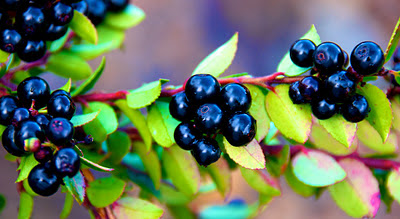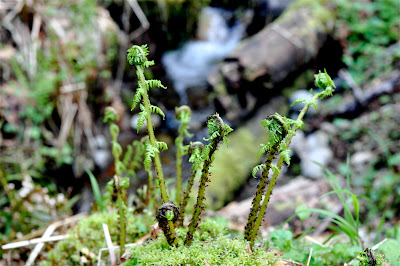AT THE HEIGHT of my recent Michigan ramp delirium, I found myself at the Marquette airport clutching a duffel bag stuffed with ramps. “Would you like to carry that on?” inquired the checker.
Absolutely.
A recipe was waiting at home in my in-box, compliments of my friends and ramp initiators, Russ and Carol. They call this dish Slippery Chicken and Ramps, which strikes me as a good name for a meal that was finessed through various checkpoints. I rounded out the menu with a simple Drunken Clams with Ramps.
 Slippery Chicken and Ramps
Slippery Chicken and Ramps1 lb chicken breast or thighs, cut into thin 2-inch strips
1 tbsp corn starch
1 tbsp sesame oil
1 tsp dark soy sauce
2 tsp soy sauce
2-3 tbsp peanut oil
1 heaping tbsp diced garlic
1 heaping tbsp diced ginger
1 tbsp fermented black beans
1 thick handful fresh ramps
splash Chinese cooking wine
1. Mix corn starch, sesame oil, and soy sauces together into marinade. Stir in chicken pieces and set aside for at least an hour.
2. Cut off ramp bulbs and separate from green leaves. Thinly slice bulbs. Roughly chop leaves.
3. Heat 1 to 2 tbsp peanut oil in wok. Saute chicken over medium-high heat until barely cooked through. Don’t overcook. Remove from wok.
4. Heat 1 tbsp peanut oil in wok and saute garlic, ginger, and black beans until fragrant, a minute or so. Add sliced ramp bulbs and cook until translucent.
5. Deglaze wok with a splash of Chinese cooking wine. Add remaining chopped ramps, which will reduce like spinach.
6. Increase heat to high and toss in chicken. Stir quickly to mix, then serve.
The name is apt. Slippery Chicken, thanks to the marinade and careful cooking, should be velvety tender. In fact, you’ll most often see it called Velvet Chicken, with some recipes using egg whites to achieve this effect. I found the mixture of oil, corn starch, and soy sauce to be plenty slippery without the use of egg whites. You can spice up this dish with Sichuan peppercorns, chili paste, black vinegar, or other typical Sichuan ingredients.
Drunken Clams with Ramps
40 Manila clams
1 tbsp peanut oil
1 heaping tbsp diced garlic
1 heaping tbsp diced ginger
1 handful fresh ramps
1 cup Chinese rice wine
1 tsp aji-mirin
1 tsp sesame oil
1. Cut off ramp bulbs and separate from green leaves. Thinly slice bulbs. Roughly chop leaves.
2. Heat peanut oil in wok. Over medium heat, saute garlic, ginger, and sliced ramp bulbs, until ramps soften, careful not to burn garlic and ginger, a minute or two.
3. Add rice wine and aji-mirin, raise heat, and bring to boil.
4. Stir in clams and cover.
5. When clams begin to open, stir in chopped ramp leaves and cover again. Cook another minute until clams fully open.
Serve Slippery Chicken and Drunken Clams with rice.
Like this:
Like Loading...


































